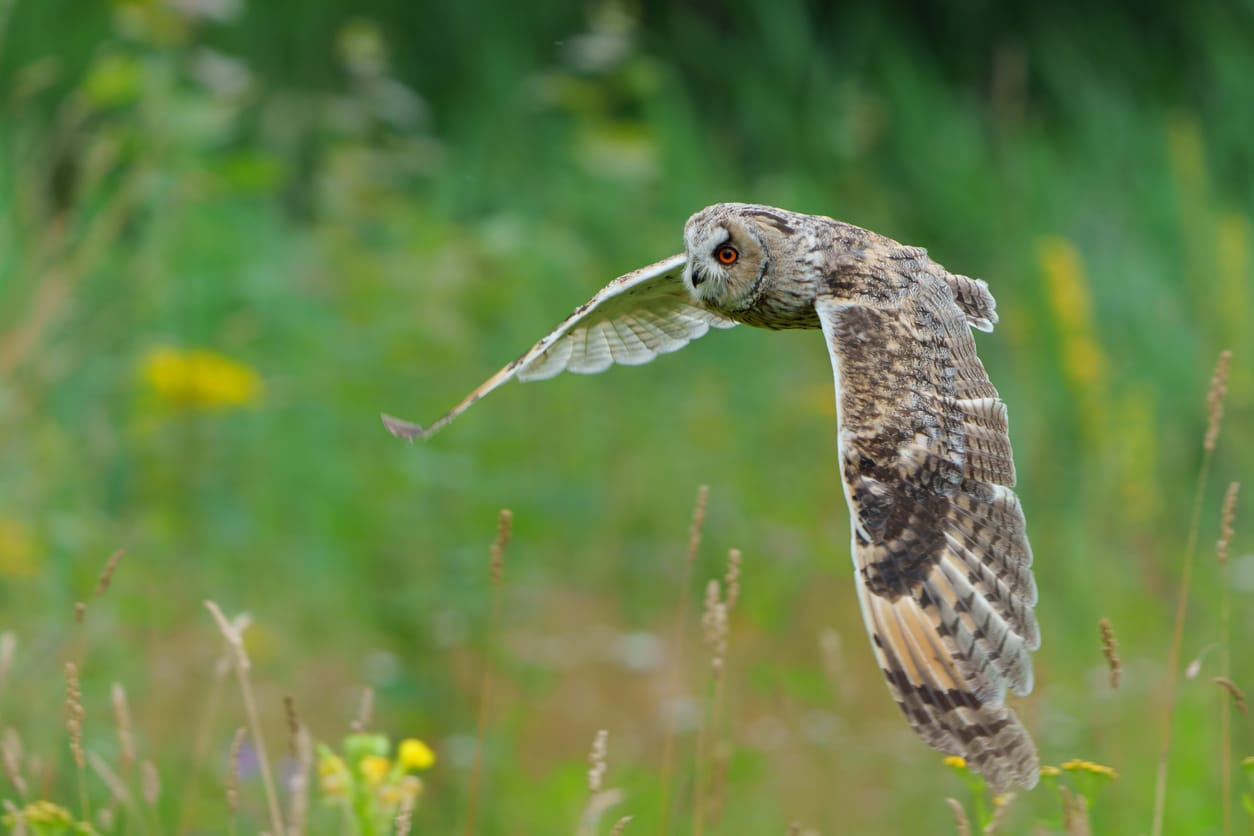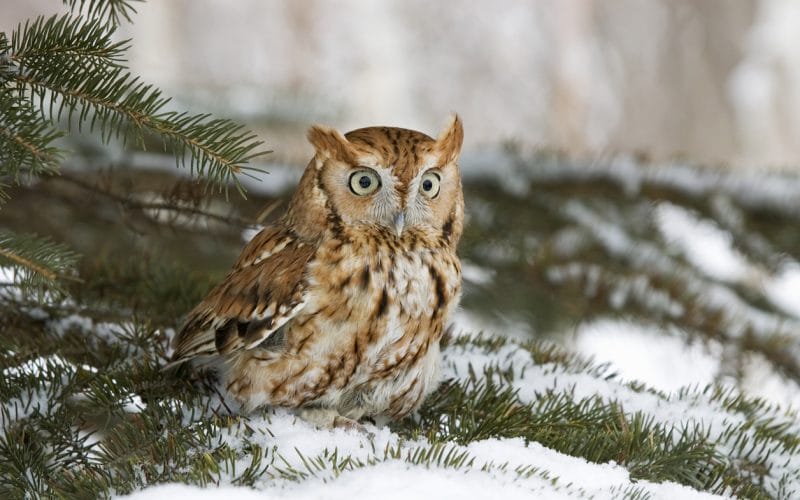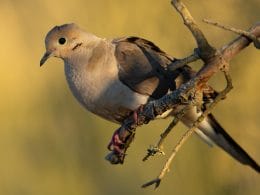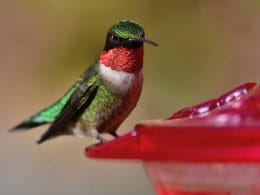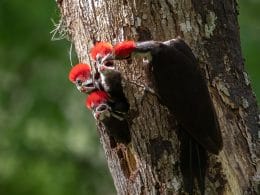Colorado is teeming with wildlife, that’s for sure, especially when it comes to birds. The state is home to more than 500 bird species, from tiny woodpeckers to proud-and-powerful hawks.
Today, our main focus is owls in Colorado, and we were thrilled to find that there are 13 types of those in this state alone. In this article, we’ll get to know these fascinating birds a little better, introducing you to their physical features, habits, natural habitats, and more.
Now, you’re probably intrigued, so let’s dive in!
1. Great Horned Owl
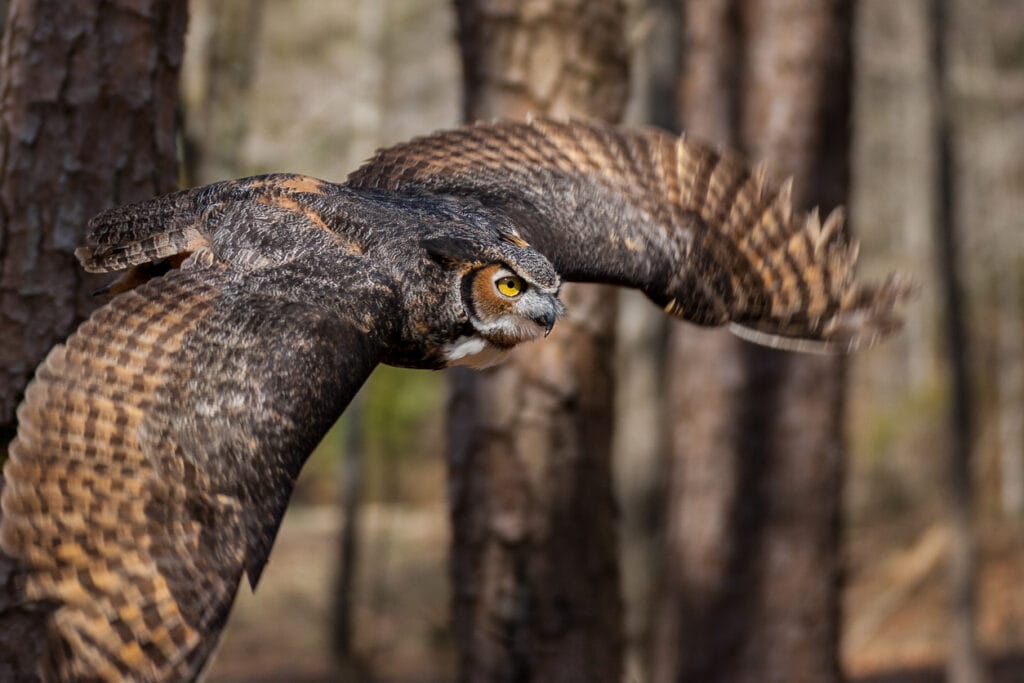
- Scientific name: Bubo virginianus
- Length: 18.1-24.8 in
- Weight: 32.1-88.2 oz
- Wingspan: 39.8-57.1 in
The Great Horned Owl is pretty common across North America, and it resides in 48 states, including, of course, Colorado. Yet, that’s not the only thing that’s special about this beautiful creature.
Great Horned Owls are a piece of cake to identify because their appearance is the first thing to come to mind when you think about owls. Because this species is depicted in the media more often than others, you’ll easily recognize one if it’s perched on a tree branch.
Author Note: This owl is known for its yellow eyes, relatively large body, and ear tufts.
When it comes to eating habits, the Great Horned Owl likes to munch on anything from mice and frogs to scorpions and even, surprisingly, skunks.
If you’re ready to search for a Great Horned Owl to get a closer look, there are many places where you can start your mission. Forests, grasslands, wetlands, and sometimes backyards make great homes for Great Horned Owls.
2. Long-eared Owl
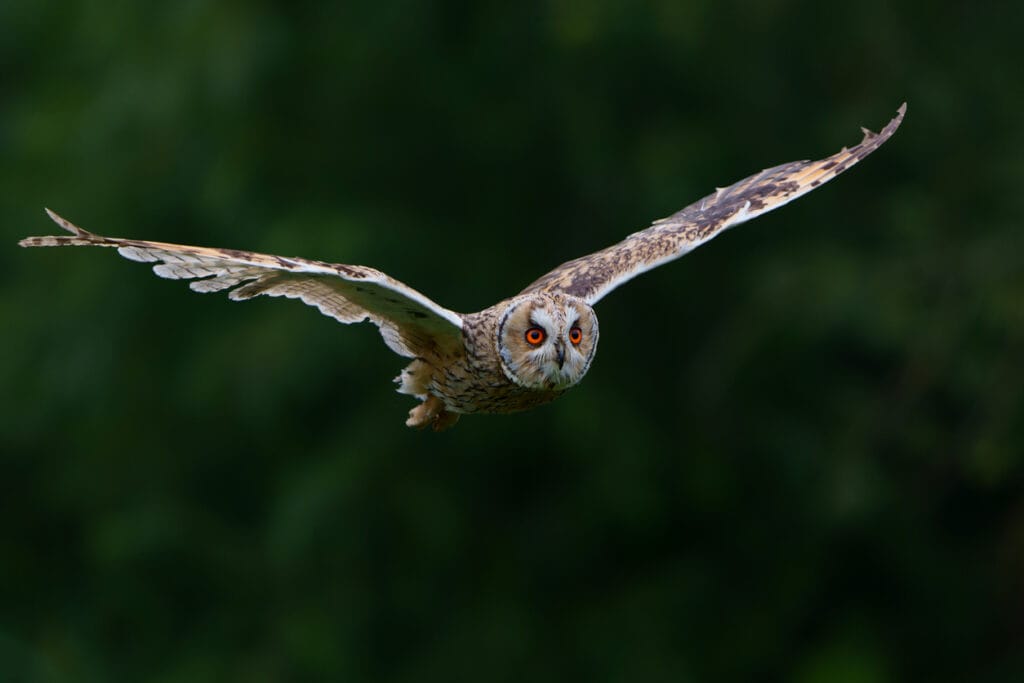
- Scientific name: Asio otus
- Length: 13.8-15.8 in
- Weight: 7.8-15.3 oz
- Wingspan: 35.4-39.4 in
Although not as popular as the Great Horned Owl, the Long-eared Owl is one you might be also familiar with. It’s famous for its yellow eyes, heart-shaped face, and, yes, characteristically long ears!
This owl lives in many states at different times of the year. But, luckily for you, it’s a permanent resident of Colorado. You can stumble upon this nocturnal bird in areas that are dense with trees, especially when it’s the roosting season.
Otherwise, this owl can be seen in open spaces when it’s hunting time.
However, keep in mind that the Long-eared Owl likes its privacy, not to mention that it’s very stealthy. Therefore, unless you know exactly where to look, it can be hard to witness this owl without putting a lot of effort into it.
Just like most owls, the Long-eared Owl feeds on small mammals such as rats, mice, rabbits, and voles. Some owls have a taste for lizards, bats, squirrels, and chipmunks, although it’s rare.
3. Short-eared Owl
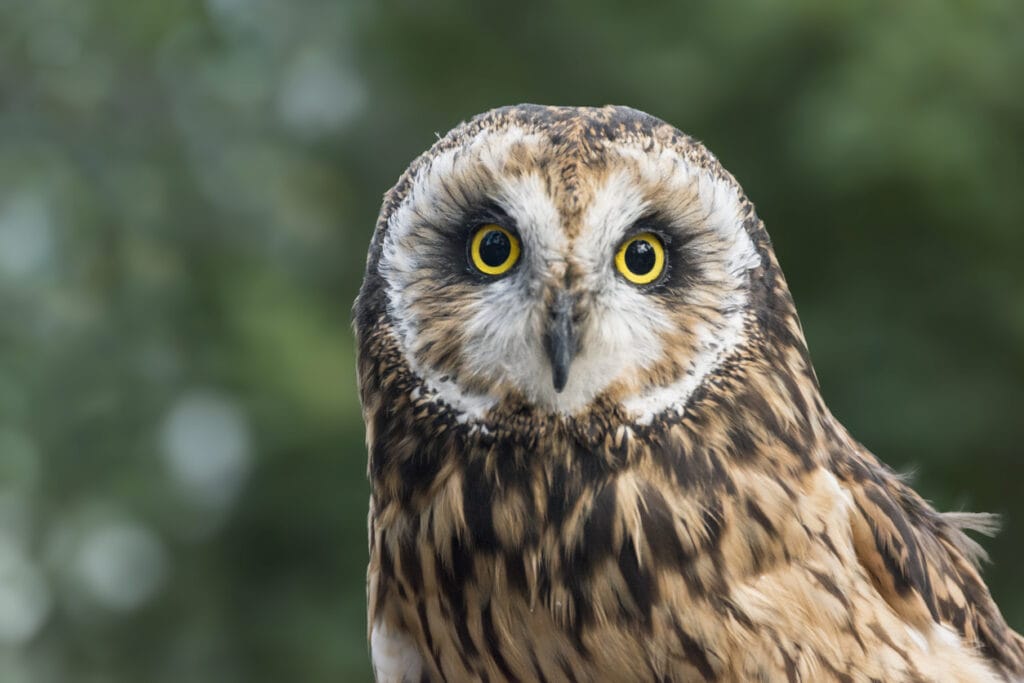
- Scientific name: Asio flammeus
- Length: 13.4-16.9 in
- Weight: 7.3-16.8 oz
- Wingspan: 33.5-40.5 in
Just like the previous one, this owl has a unique heart-shaped face and a pair of yellow eyes. Yet, as the name suggests, the Short-eared Owl is easily distinguishable by its tiny ears.
What’s so great about this owl is that you’ll have a higher chance of witnessing it in Colorado during winter. All you’ll have to do is look in open fields or grasslands. You might just see one flying low to snatch its prey from the ground.
The Short-eared Owl tends to be most active around dusk or dawn because that’s when it usually hunts.
As for its favorite food, the Short-eared Owl prefers to eat mice, rabbits, voles, and weasels. It also likes to feast on songbirds and gulls from time to time.
4. Barn Owl
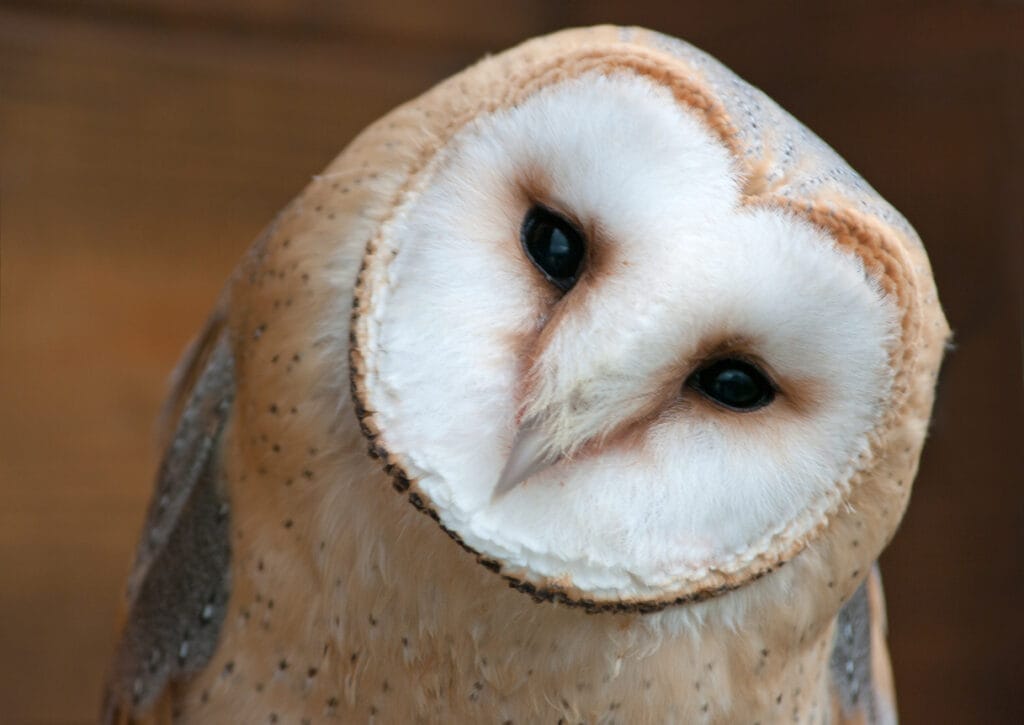
- Scientific name: Tyto alba
- Length: 12.6-15.8 in
- Weight: 14.1-24.7 oz
- Wingspan: 39.4-49.2 in
The Barn Owl is another owl you’re probably familiar with thanks to its unforgettable face shape. Its face is usually white, shaped like a heart, and features two big, black eyes.
Author Note: Although Barn Owls are widespread across the entire world and there’s a heavy population of them in North America, they’re rarely seen. That’s because they’re professionals when it comes to sneaking around undetected.
Still, if you want to increase the possibilities of seeing one, you’ll have to know where to look. Barn Owls usually nest in forests, deserts, grasslands, marshes, and, yes, several man-made structures including barns.
5. Eastern Screech-Owl

- Scientific name: Megascops asio
- Length: 6.3-9.8 in
- Weight: 4.3-8.6 oz
- Wingspan: 18.9-24.0 in
You’ll take one look at the Eastern Screech-Owl and admit that it’s the cutest thing you’ve ever seen! Its stocky frame, attractive gray-and-white or brown-and-white patterns, and curious eyes are part of the charm.
However, if you don’t live in the easternmost part of Colorado, right near the border, you might need to pack your bags and head over there to see the Eastern Screech-Owl. The cavities of trees, especially in a heavily-wooded area, are this owl’s favorite location to nest.
Because of its mini size, the Eastern Screech-Owl’s diet consists of small mammals, insects, and even birds. Mice, moles, rabbits, earthworms, frogs, doves, and woodpeckers are only a few examples of what this owl likes to have for dinner!
6. Western Screech-Owl

- Scientific name: Megascops kennicottii
- Length: 7.5-9.8 in
- Weight: 3.5-10.8 oz
- Wingspan: 21.6-24.4 in
Western Screech-Owls are naturally camouflaged, just like Eastern Screech-Owls, and they’ll blend in with tree trunks seamlessly. Therefore, it can be hard to know if you’re in the presence of one unless you hear a “toot-toot” sound and start looking more closely for the source.
In Colorado, Western Screech-Owls might be seen in southern and southeastern regions. You’ll just have to search in open woodlands and, sometimes, urban areas.
One of the coolest things about Western Screech-Owls is that they have so much energy packed in such small bodies. Sure, they’ll chew on tiny insects or mice, but they’re also capable of feasting on rabbits that dwarf them!
7. Northern Saw-whet Owl
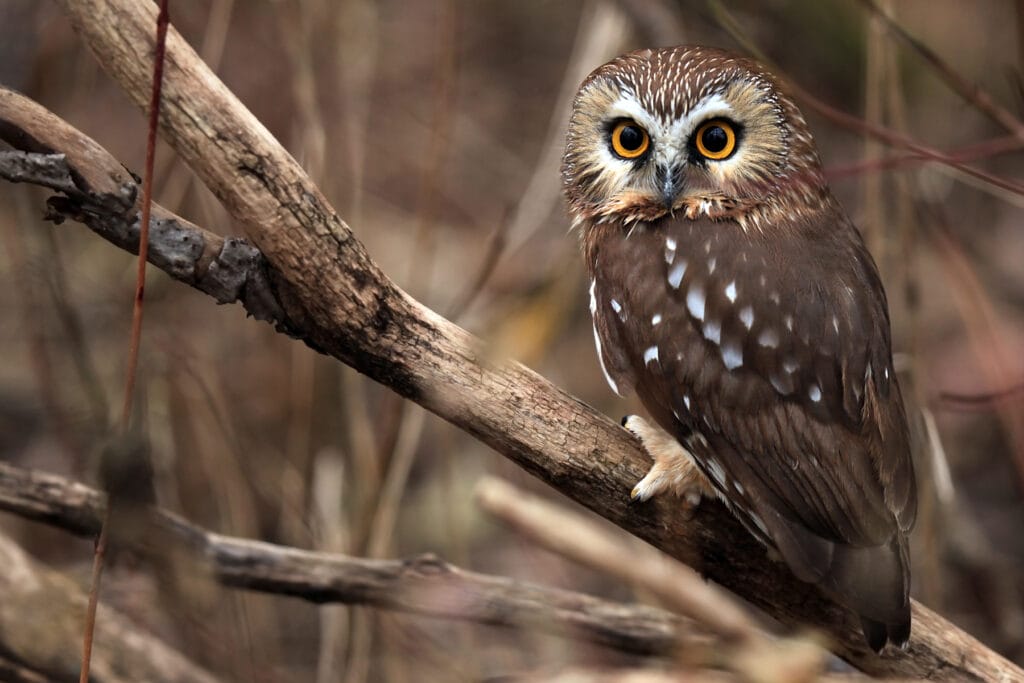
- Scientific name: Aegolius acadicus
- Length: 7.1-8.3 in
- Weight: 2.3-5.3 oz
- Wingspan: 16.5-18.9 in
The Northern Saw-whet Owl is a bit smaller than the previous two owls, but it’s a whole new version of special. It has an oversized head with a face shaped like a cat’s and large yellow eyes.
Author Note: If you’re wondering about the reason behind its strange name, well, it all goes back to what one of its calls sounds like. Some experts, after hearing that particular call, couldn’t help but compare it to the noise that comes out if you sharpen a saw on a whetting stone.
Because the Saw-whet Owl is highly elusive, it’s somewhat challenging to stumble upon if you don’t know where to look. In Colorado, your best chance of finding this owl is if you search in forests.
8. Boreal Owl
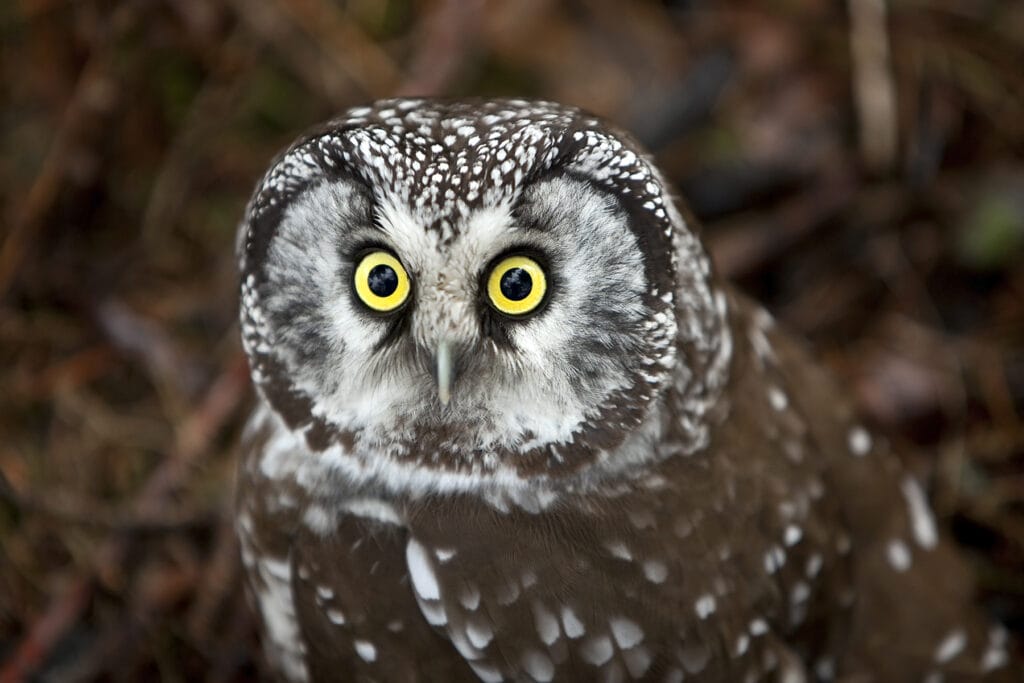
- Scientific name: Aegolius funereus
- Length: 8.3-11.0 in
- Weight: 3.3-7.6 oz
- Wingspan: 21.6-24.4 in
Due to its uniquely-shaped head and small size, the Boreal Owl is a breeze to identify compared to the rest of the owls on our list. It’s known for its large, square head, a white facial disc, and the dark border of feathers that surrounds the face.
The Boreal Owl isn’t as widespread in the U.S. as the Barn Owl or the Saw-whet Owl as it’s found in seven states only. Thankfully, Colorado is one of them, and you can look for this owl in the northern and central parts of the state.
However, the Boreal Owl is only active at night and it’s very careful around humans, so it’s rarely seen. Still, you could try to attract it to your backyard if you install a nesting box.
The Boreal Owl’s favorite food includes small mammals, insects, and, on occasion, other birds.
9. Burrowing Owl
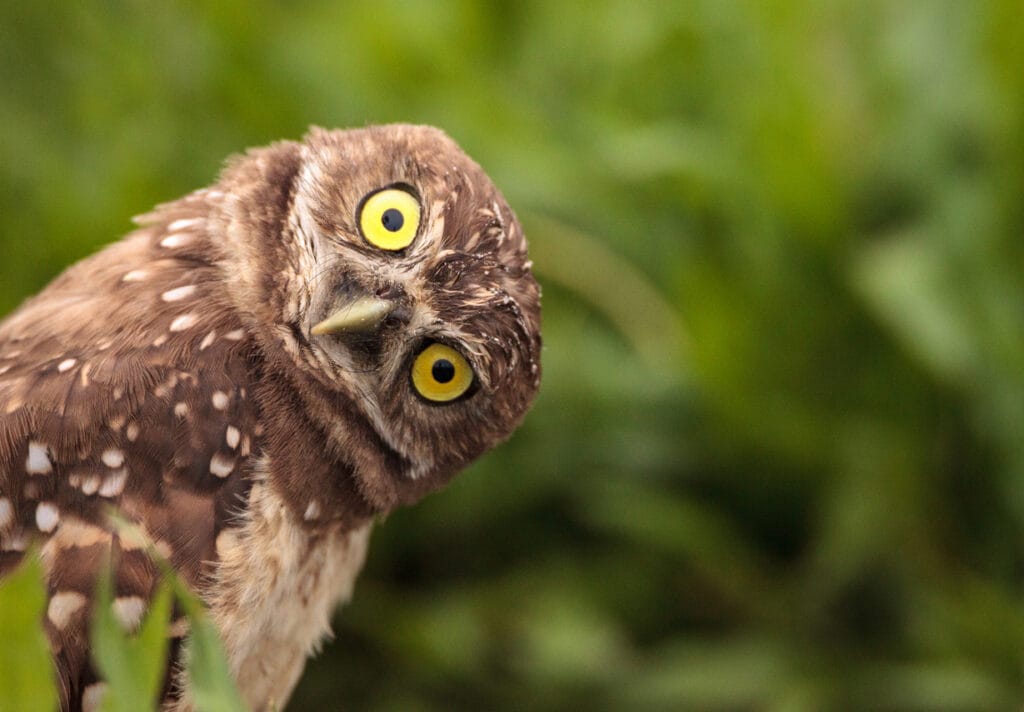
- Scientific name: Athene cunicularia
- Length: 7.5-9.8 in
- Weight: 5.3 oz
- Wingspan: 21.6 in
The Burrowing Owl looks like a cross-breed between our general view of an owl and an eagle or a hawk. That’s because of its characteristically long legs, which aren’t very common in owls, and slim body.
In Colorado, Burrowing Owls only have a breeding range, so you might witness one when the weather gets warm. These buddies are the only birds of prey that nest and roost underground, creating their own burrows or using the ones left behind by groundhogs.
Burrowing Owls like to hunt on the ground for delicious invertebrates and small vertebrates.
10. Snowy Owl
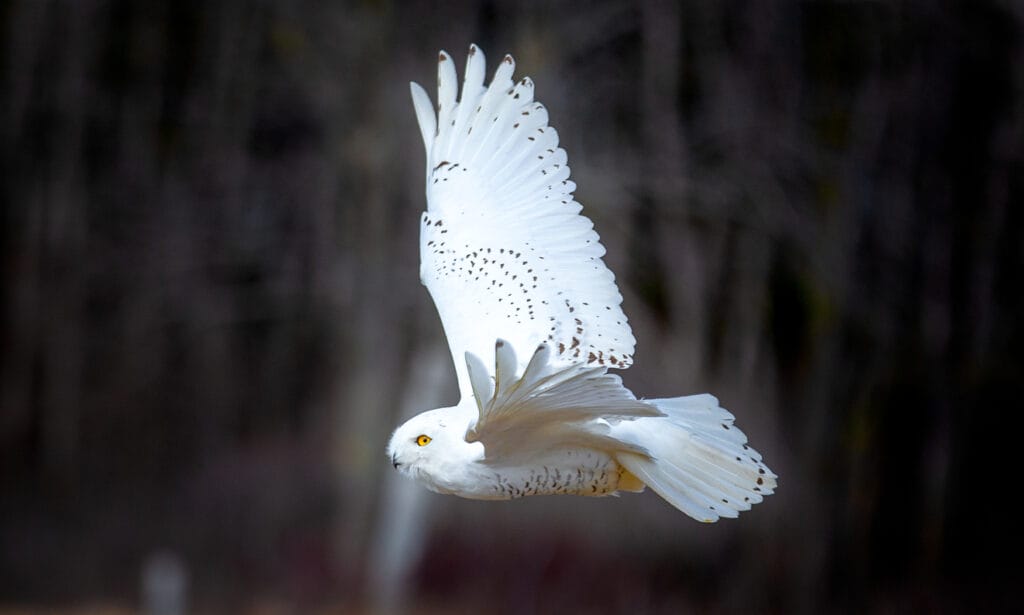
- Scientific name: Bubo scandiacus
- Length: 20.5-27.9 in
- Weight: 56.4-104.1 oz
- Wingspan: 49.6-57.1 in
As the name suggests, the Snowy Owl has beautiful white plumage that can sometimes include gray or black streaks. It’s not very common in Colorado, but you might be lucky enough to see one close to a lake or any other body of water where it usually likes to hunt.
Snowy Owls are more active during winter, too, so that’s the perfect time you should go search for one.
We were quite surprised to find out that Snowy Owls are larger than Great Horned Owls. Because of their big size and natural strength, these buddies hunt and feed on small and large animals with impressive skill.
Their diet features lemmings, rodents, rabbits, squirrels, ducks, and geese.
11. Flammulated Owl

- Scientific name: Psiloscops flammeolus
- Length: 5.9-6.7 in
- Weight: 1.5-2.2 oz
- Wingspan: 15.9-16.1 in
Flammulated Owls are some of the smallest owls you can find in Colorado where they arrive each year to breed. These fellows are pretty rare to come across, and, even if they’re around, their tiny size makes them almost invisible to the untrained eye!
Top Tip: Wondering what they look like? Well, Flammulated Owls have reddish-gray feathers, large eyes, and they’re draped in camo!
Flammulated Owls appreciate a good meal of insects more than anything else. Grasshoppers, beetles, and moths are favorites, but these owls will sometimes feed their younglings mice or bats.
12. Northern Pygmy Owl

- Scientific name: Glaucidium gnoma
- Length: 6.3-7.1 in
- Weight: 2.1-2.5 oz
- Wingspan: 14.5-16 in
Another tiny owl that you can stumble upon in Colorado is the Northern Pygmy Owl. It’s known for the white dots on its brown head, white-and-brown feathers, and yellow beaks and eyes.
Yet, the best thing about the Northern Pygmy Owl is that it’s not that hard to find in Colorado because it’s active during the day. All you’d have to do is search for them in forests near mountainous regions, and you’ll likely see one sitting completely still, waiting for its prey with patience.
What’s even more interesting about this owl is that it can put up quite the fight, enabling it to hunt birds and mammals three times its size!
13. Mexican Spotted Owl

- Scientific name: Strix occidentalis
- Length: 18.5-18.9 in
- Weight: 17.6-24.7 oz
- Wingspan: 39.8 in
The Mexican Spotted Owl is only found in limited pockets in Colorado as it’s listed as threatened in the U.S. Part of its status is due to the loss of habitat, the other part is because the Barred Owl, which is larger and more fierce, keeps driving the Mexican Spotted Owl away.
Therefore, it can be next to impossible to locate this owl in Colorado, but you can always give it a try. Look for it in forests and woodlands and wait until you hear its hooting call at night.
The diet of a Mexican Spotted Owl is a huge one as it likes to eat small birds, rodents, insects, and amphibians.
Final Words
What can possibly be more fun than trying to find all 13 species of owls in Colorado, especially if you’re passionate about bird watching?
These mighty beasts have different appearances, habits, and hunting styles. Yet, what they all have in common is a keen eye and unbelievable strength that no one could deny. Even the smallest owls can pick up a fight with larger mammals.
We hope you enjoyed this guide on common owls in Colorado!
FAQ
Barr Lake State Park, Cherry Creek State Park, Chico Basin Ranch, John Martin Reservoir State Park, Pawnee National Grassland are all good for the Burrowing Owl.
Given that Audubon recommend all those places for the Burrowing Owl, it must be the most common owl in Colorado.
To find out where recent sightings of owls have been, try eBird. You can search for the latest sightings or particular species or what has been seen in a certain area.




